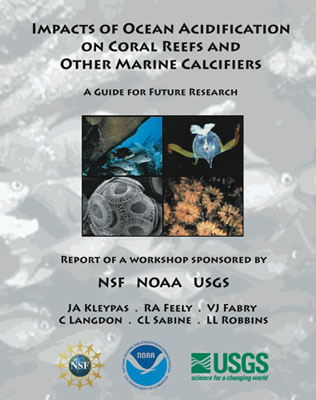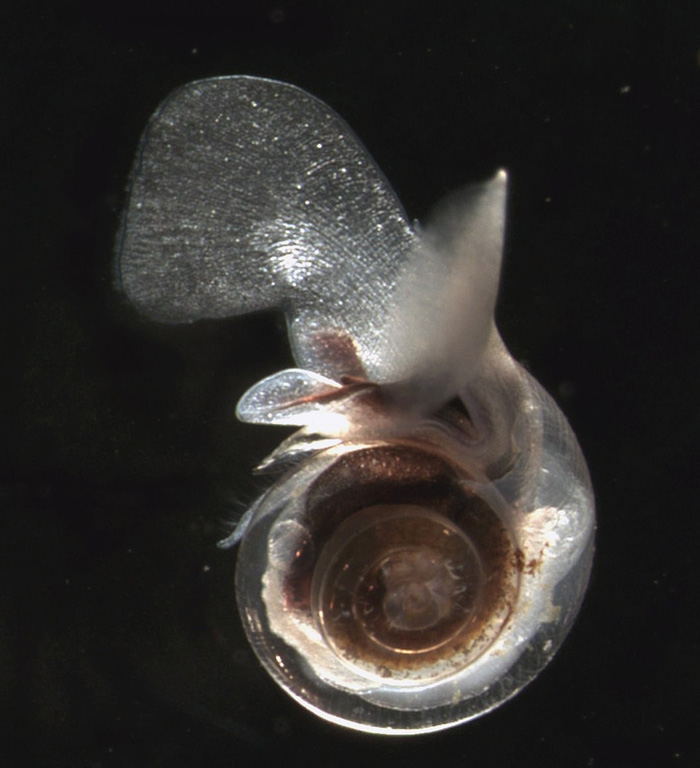PMEL Ocean Acidification Home Page
 What is Ocean Acidification
What is Ocean Acidification
Additional Ocean acidification sites:
 What is Ocean Acidification
What is Ocean Acidification
- NOAA Ocean Acidification Fact Sheet
-
The Federal Ocean Acidification Research and Monitoring Act: H.R. 4174
Link to the House Science Committee, Subcommittee on
Energy and Environment's hearing on 'The Federal Ocean Acidification
Research and Monitoring Act: H.R. 4174' featuring Dr. Richard
Feely (PMEL) as a witness.
On the right hand side of the website, under "Webcast Info" is a link to
the webcast in RealPlayer format.
-
NOAA Ocean Acidification Research Planning Meeting: Summary and Presentations
- NOAA WASC Ocean Acidification Research Plan
| The following images link to further information on ocean acidification: | |
 Ocean Acidification Mooring:
As one of the oldest oceanic time series sites, Ocean Station Papa
(50°N, 145°W) is a critical site in the global network of OceanSITES
time series reference sites. Through support from the US NSF and NOAA
and in collaboration with the Canadian DFO Line P Program, a surface
mooring was deployed in June 2007 at Ocean Station Papa to monitor
ocean-atmosphere interactions, carbon uptake, and ocean acidification.
Ocean Acidification Mooring:
As one of the oldest oceanic time series sites, Ocean Station Papa
(50°N, 145°W) is a critical site in the global network of OceanSITES
time series reference sites. Through support from the US NSF and NOAA
and in collaboration with the Canadian DFO Line P Program, a surface
mooring was deployed in June 2007 at Ocean Station Papa to monitor
ocean-atmosphere interactions, carbon uptake, and ocean acidification.
|
|
 How is ocean acidity changing?
How will ecosystems be affected? What research is being done?
For the answers to these questions and more, click the image to the left to
go to the Ocean Acidification Network, an information network
for the internal scientific community.
How is ocean acidity changing?
How will ecosystems be affected? What research is being done?
For the answers to these questions and more, click the image to the left to
go to the Ocean Acidification Network, an information network
for the internal scientific community.
|
|
 Second Symposium on The Ocean in a High-CO2 World
6 - 9 October 2008 Musée Océanographique, Monaco.
The purpose of the meeting is to provide an interdisciplinary forum to
assess what is known about ocean acidification and to identify priorities
for future research. For more information on this symposium, click the image to the left.
Second Symposium on The Ocean in a High-CO2 World
6 - 9 October 2008 Musée Océanographique, Monaco.
The purpose of the meeting is to provide an interdisciplinary forum to
assess what is known about ocean acidification and to identify priorities
for future research. For more information on this symposium, click the image to the left.
|
|
 The Future Oceans – Warming Up, Rising High, Turning Sour
Latest research findings show that failure to check mankind’s emissions of
carbon dioxide will have severe consequences for the world’s oceans.
The marine environment is doubly affected: continuing warming and
ongoing acidification both pose threats. In combination with over-fishing,
these two threats are further jeopardizing already weakened fish stocks.
Sea-level rise is exposing coastal regions to mounting flood and hurricane
risks. Click the image to the left for the full report.
The Future Oceans – Warming Up, Rising High, Turning Sour
Latest research findings show that failure to check mankind’s emissions of
carbon dioxide will have severe consequences for the world’s oceans.
The marine environment is doubly affected: continuing warming and
ongoing acidification both pose threats. In combination with over-fishing,
these two threats are further jeopardizing already weakened fish stocks.
Sea-level rise is exposing coastal regions to mounting flood and hurricane
risks. Click the image to the left for the full report.
|
|
 The Ocean Carbon and Biogeochemistry Group
seeks to to establish the evolving role of the ocean in the global carbon
cycle in the face of environmental change through studies of
marine biogeochemical cycles and associated ecosystems.
Click on the image at left to read more.
The Ocean Carbon and Biogeochemistry Group
seeks to to establish the evolving role of the ocean in the global carbon
cycle in the face of environmental change through studies of
marine biogeochemical cycles and associated ecosystems.
Click on the image at left to read more.
|
|
 Impacts of Ocean Acidification on Coral Reefs and Other Marine Calcifiers
July 5, 2006: Worldwide emissions of carbon dioxide from fossil fuel burning are dramatically altering ocean chemistry
and threatening marine organisms, including corals, that secrete skeletal structures and support
oceanic biodiversity. The report (accessed via the picture at left) released today summarizes the known
effects of increased atmospheric carbon dioxide on these organisms, known as marine calcifiers, and recommends
future research for determining the extent of the impacts.
Click the image to the left for the full report.
(9,677 KB PDF)
Impacts of Ocean Acidification on Coral Reefs and Other Marine Calcifiers
July 5, 2006: Worldwide emissions of carbon dioxide from fossil fuel burning are dramatically altering ocean chemistry
and threatening marine organisms, including corals, that secrete skeletal structures and support
oceanic biodiversity. The report (accessed via the picture at left) released today summarizes the known
effects of increased atmospheric carbon dioxide on these organisms, known as marine calcifiers, and recommends
future research for determining the extent of the impacts.
Click the image to the left for the full report.
(9,677 KB PDF)
|
|
 Carbon Dioxide and Our Ocean Legacy April 7, 2006:
Global climate change is increasing ocean temperatures
and raising sea levels. New scientific
research shows that our oceans are beginning
to face yet another threat due to global climate change -
their basic chemistry is
changing because of the uptake of carbon
dioxide released by human activities.
Click the image to the left for the full report.
(100KB PDF)
Carbon Dioxide and Our Ocean Legacy April 7, 2006:
Global climate change is increasing ocean temperatures
and raising sea levels. New scientific
research shows that our oceans are beginning
to face yet another threat due to global climate change -
their basic chemistry is
changing because of the uptake of carbon
dioxide released by human activities.
Click the image to the left for the full report.
(100KB PDF)
|
|
 The Dangers of Ocean Acidity:
The Dangers of Ocean Acidity:
Listen to RealAudio Listen to MP3 April 6, 2006: Are humans changing the chemistry of the world's oceans by burning fossil fuels? Is carbon dioxide a threat to coral reefs and marine ecosystems? The problem starts with fuels like coal and gas that release carbon dioxide into the atmosphere. The excess carbon dioxide contributes to global warming. But carbon dioxide is not just making things hotter. It's also changing the chemistry of the world's oceans. Is the 'acidification' of seawater a threat to the future of coral reefs and other living organisms? |
|
 NOAA / NSF Cruise reveals impacts of ocean acidification on chemistry, biology of North Pacific Ocean
April 5, 2006: Data collected from ocean sampling in the Pacific Ocean from the southern to
northern hemispheres confirms that the oceans are becoming more acidic. A recently completed field
study from Tahiti to Alaska collecting data about the effects of ocean acidification on the water
chemistry and marine organisms found evidence that verifies earlier computer model projections. These
findings are consistent with data from previous field studies conducted in other oceans.
Click the image to the left for the full story.
NOAA / NSF Cruise reveals impacts of ocean acidification on chemistry, biology of North Pacific Ocean
April 5, 2006: Data collected from ocean sampling in the Pacific Ocean from the southern to
northern hemispheres confirms that the oceans are becoming more acidic. A recently completed field
study from Tahiti to Alaska collecting data about the effects of ocean acidification on the water
chemistry and marine organisms found evidence that verifies earlier computer model projections. These
findings are consistent with data from previous field studies conducted in other oceans.
Click the image to the left for the full story.
|
|
 Results from Workshop on the Impacts of Increasing Atmospheric CO2 on
Coral Reefs and Other Marine Calcifiers.
Calcification rates of several major groups of marine calcifying organisms, from both neritic and pelagic environments,
will very likely decrease in response to changes in ocean carbonate chemistry. Although benthic and planktonic calcifiers
of both neritic and pelagic communities display a similar response to increased CO2
forcing, important differences exist between the two that will dictate different approaches toward assessing
the larger potential effects of reduced calcification on ecosystem structure and function, how the effects could
cascade to other ecosystems, and ultimately, the changes in the ocean carbon cycle. Click on the image to the
left for results from the April 2005 Workshop in Florida.
Results from Workshop on the Impacts of Increasing Atmospheric CO2 on
Coral Reefs and Other Marine Calcifiers.
Calcification rates of several major groups of marine calcifying organisms, from both neritic and pelagic environments,
will very likely decrease in response to changes in ocean carbonate chemistry. Although benthic and planktonic calcifiers
of both neritic and pelagic communities display a similar response to increased CO2
forcing, important differences exist between the two that will dictate different approaches toward assessing
the larger potential effects of reduced calcification on ecosystem structure and function, how the effects could
cascade to other ecosystems, and ultimately, the changes in the ocean carbon cycle. Click on the image to the
left for results from the April 2005 Workshop in Florida.
|
|
Additional Ocean acidification sites:
- Coastal Ecosystem Effects of Climate Change: Ocean Acidification
- An information outlet on Ocean Acidification
- Marine Climate Change Impacts Partnership - Acidification
- OSPAR Report on Ocean Acidification MS WORD DOCUMENT: Effects on the marine environment of ocean acidification resulting from elevated levels of CO2 in the atmosphere.